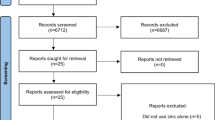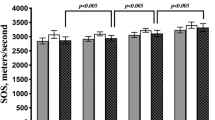Abstract
We evaluated the relationship between child (aged 6–36 months) height and blood zinc, copper, iron, calcium, and magnesium concentrations. We selected 840 children following a physical examination. Weight and supine length or standing height were measured according to the World Health Organization guidelines. Polarographic analysis was used to measure zinc, copper, iron, magnesium, and calcium levels. Differences in heights between groups with low vs. high mineral concentrations, stratified by sex and age, were compared by analysis of variance. Relationships between these five elements and heights were tested by multiple regression analysis. Zinc levels in the shorter group (height for age (HAZ) ≤ −0.3) were 135.84 ± 39.76 and 134.83 ± 37.57 μmol/L in boys and girls, respectively. Zinc concentrations in the taller group (HAZ > −0.3) were 142.50 ± 35.85 and 140.52 ± 35.80 μmol/L in boys and girls, respectively. The difference between the two height groups in boys and girls was statistically significant. Compared with those (143.06 ± 33.76 μmol/L) in the taller group, zinc concentration (131.30 ± 40.75 μmol/L) in the shorter group was significantly lower (p = 0.04) at age 6–12 months. Height was positively correlated with zinc level in children aged 6–12 months (p < 0.05). Zinc levels were positively correlated with calcium, magnesium, and iron concentrations in children aged 6–36 months (p < 0.05). Our results indicated that zinc levels and height are correlated, and zinc levels were related to calcium, magnesium, copper, and iron concentrations. Therefore, to ensure healthy development in children, blood levels of these five elements should be balanced.
Similar content being viewed by others
References
Larkin EC, Rao CA (1990) Importance of fetal and neonatal iron: adequacy for normal development of central nervous system. In: Dobbing J (ed) Brain behaviour and iron in the infant diet. Springer, London, pp. 43–63
Koolman J, Roehm KH (2005) Color atlas of biochemistry. Thieme, Marburg
Yamaguchi M, Gao YH, Ma ZJ (2000) Synergistic effect of genistein and zinc on bone components in the femoral-metaphyseal tissues of female rats. J Bone Miner Metab 18:77–83
Bouglé DL, Sabatier JP, Guaydier-Souquières G, Guillon-Metz F, Laroche D, Jauzac P, Bureau F (2004) Zinc status and bone mineralisation in adolescent girls. J Trace Elements Med Biol 18:17–21
Reginster JY, Strause LG, Saltman O, Franchimont P (1988) Trace elements and postmenopausal osteoporosis: a preliminary study of decreased serum manganese. Med Sci Res 16:337–338
Ma ZJ, Yamaguchi M (2001) Role of endogenous zinc in the enhancement of bone protein synthesis associated with bone growth of newborn rats. J Bone Miner Metab 19:38–44
Beattie JH, Avenell A (1992) Trace element nutrition and bone metabolism. Nutr Res Re 5:167–188
Medeiros DM, Plattner A, Jennings D, Stoecker B (2002) Bone morphology, strength and density are compromised in iron-deficient rats and exacerbated by calcium restriction. J Nutr 132:3135–3141
Ye J, Du C, Wang L, Li Z, Huang S, Wang H, He L, Bi Y, Wang C (2015) Relationship of blood levels of Pb with Cu, Zn, Ca, Mg, Fe, and Hb in children aged 0 approximately 6 years from Wuhan, China. Biol Trace Elem Res 164:18–24
Hu JF, Zhao XH, Jia JB, Parpia B, Campbell TC (1993) Dietary calcium and bone density among middle-aged and elderly women in China. Am J Clin Nutr 58:219–227
Matkovic V, Ilich JZ (1993) Calcium requirements for growth: are current recommendations adequate? Nutr Rev 51:171–180
Singh P, Toteja GS (2003) Micronutrient profile of Indian children and women: summary of available data from iron and vitamin a. Indian Pediatr 40:477–479
Lee WT, Leung SS, Leung DM, Tsang HS, Lau J, Cheng JC (1995) Randomized double-blind controlled calcium supplementation trial, and bone and height acquisition in children. Br J Nutr 74:125–139
Winzenberg T, Shaw K, Fryer J, Jones G (2007) Calcium supplements in healthy children do not affect weight gain, height, or body composition. Obesity (Silver Spring) 15:1789–1798
Mason JB, Lotfi M, Dalmiya N, Sethuraman K, Deitchler M, Geibel S, Gillenwater K, Gillman A, Mason K, Mock N (2000) United Nations administrative committee on coordination subcommittee on nutrition: fourth report on the world nutrition situation. Switzerland, Geneva
Gibson RS (2000) Zinc supplementation for infants. Lancet 355:2008–2009
Fukada T, Yamasaki S, Nishida K, Murakami M, Hirano T (2011) Zinc homeostasis and signalling in health and diseases. J Biol Inorg Chem 16:1123–1134
Prasad AS (1995) Zinc: an overview. Nutrition 11:93–99
Lianhe XG (2010) Analysis of trace elements of children aged from 0 to 7 years old in Hanzhong China. Stud Trace Elem Health 27:3–4
Knerr I, Blessing H, Seyferth S, Watling RJ, Chaudhri MA (2013) Evaluation of plasma trace element and mineral status in children and adolescents with phenylketonuria using data from inductively-coupled-plasma atomic emission and mass spectrometric analysis. Ann Nutr Metab 63:168–173
Taneja S, Strand T, Sommerfelt H, Bahl R, Bhandari N (2010) Zinc supplementation for four months does not affect growth in young north Indian children. J Nutr 140:630–634
Cao J, Gao Z, Yan J, Li M, Su J, Xu J,Yan CH (2015) Evaluation of trace elements and their relationship with growth and development of young children. Biol Trace Elem Res DOI:0.1007/s12011–015–0537-7.
Sungthong R, Mo-Suwan L, Chongsuvivatwong V, Geater AF (2002) Once weekly is superior to daily iron supplementation on height gain but not on hematological improvement among schoolchildren in Thailand. J Nutr 132:418–422
Jabbari H, Bakhshian F, Asgari M, Sattari M, Naghavi-Behzad M, Mashayekhi SO (2013) Antenatal micronutrient supplementation relationship with children's weight and height from birth up to the age of 18 months Iranian. Iran J Public Health 42:626–634
Kanani SJ, Poojara RH (2000) Supplementation with iron and folic acid enhances growth in adolescent Indian girls. J Nutr 130:452S–455S
Ralph A,Arthur J,Garrow JS,James PT, Ralph A (2000) Iron, zinc and other trace elements.In: Human nutrition and dietetics, 10th edn. Churchill Livingstone, New York.
Soetan KO, Olaiya CO, Oyewole OE (2010) The importance of mineral elements for humans, domestic animals and plants. Afr J Food Sci 4:200–222
Duley L, Henderson-Smart DJ, Walker JA, Chou D (2010) Magnesium sulphate versus diazepam for eclampsia. Cochrane Database Syst Rev 12:CD000127. doi:10.1002/14651858.CD000127.pub2
Angelova MG, Petkova-Marinova TV, Pogorielov MV, Loboda AN, Nedkova-Kolarova VN, Bozhinova AN (2014) Trace element status (iron, zinc, copper, chromium, cobalt, and nickel) in iron-deficiency anaemia of children under 3 years. Anemia 2014:718089. doi:10.1155/2014/718089
Suárez-Ortegón MF, Jiménez P, Mosquera M, Pradilla AG, Gracia AB, Aguilar C (2011) Inverse correlation between serum calcium and copper levels in male urban Colombian preschool children: relationships with an thropometry and age. Biol Trace Elem Res 144:445–453
Lin CN, Wilson A, Church BB, Ehman S, Roberts WL, McMillin GA (2012) Pediatric reference intervals for serum copper and zinc. Clin Chim Acta 413(5–6):612–615
Farzin L, Moassesi ME, Sajadi F, Amiri M, Shams H (2009) Serum levels of antioxidants (Zn, Cu, Se) in healthy volunteers living in Tehran. Biol Trace Elem Res 129:36–45
Rukgauer M, Klein J, Kruse-Jarres JD (1997) Reference values for the trace elements copper, manganese, selenium, and zinc in the serum/plasma of children, adolescents, and adults. J Trace Elem Med Biol 11:92–98
Ridefelt P, Aldrimer M, Rodoo P, Niklasson F, Jansson L, Gustafsson J (2011) Reference intervals for phosphate, magnesium and calcium in healthy Swedish children. Clin Biochem 44:542–543
Marwaha RK, Khadgawat R, Tandon N, Kanwar R, Narang A, Sastry A, Bhadra K, Kalaivani M (2010) Reference intervals of serum calcium, ionized calcium, phosphate and alkaline phosphatase in healthy Indian school children and adolescents. Clin Biochem 43:1217–1219
Lockltch G, Halsteed AC, Alberahelm S, Maccallum C, Qulgley G (1988) Age- and sex specific pediatric reference intervals for biochemistry analytes as measured with the Ektachem-700 analyzer. Clin Chem 34:1622–1623
Liu J, Yuan E, Zhang Z, Jia L, Yin Z, Meng X, H D (2012) Sex-specific reference intervals for blood copper, zinc, calcium, magnesium, iron, lead, and cadmium in infants and children. Clin Biochem 45(6):416–419
Grandjean P, Nielsen GD, Jorgensen PJ, Horder M (1991) Reference intervals for trace elements in blood: significance of risk factors. Scand J Clin Lab Invest 52:321–337
Ece A, Uyanik BS, Iscan A, Ertan P, Yigitoglu MR (1997) Increased serum copper and decreased serum zinc levels in children with iron deficiency anemia. Biol Trace Elem Res 59:31–39
Gleerup A, Rossander HL, Gramatkovski E, Hallberg L (1995) Iron absorption from the whole diet: comparison of the effect of two different distributions of daily calcium intake. Am J Clin Nutr 61:97–104
Hempe JM, Cousins RJ (1990) Present knowledge in nutrition. In: Brown ML (ed) . ILSI Nutrition Foundation, Washington DC, pp. 251–280
Botash AS, Nasca J, Dubowy R, Weinberger HL, Oliphant M (1992) Zinc induced copper deficiency in an infant. Am J Dis Child 146:709–711
De la Cruz-Góngora V, Gaona B, Villalpando S, Shamah-Levy T, Robledo R (2012) Anemia and iron, zinc, copper and magnesium deficiency in Mexican adolescents: National Health and nutrition survey 2006. Salud Publica Mex 54(2):135–145
Dashti-Khavidaki S, Khalili H, Vahedi SM, Lessan-Pezeshki M (2010) Serum zinc concentrations in patients on maintenance hemodialysis and its relationship with anemia, parathyroid hormoneconcentrations and pruritus severity. Saudi J Kidney Dis Transpl 21(4):641–645
Hu J, Wang AF, Qi HX, Hong Z (2014) Effect of nutritional among children with rion deficiency anemia. Chinese Journal of Health Education 30(9):795–797
Yang YY,Liu LM,Yang WF,Zhang SP,Wang Y (2014) Research on serum vitamin A, iron and zinc status of infants aged 0-18 months and the relationship with Hb in rural area of Shaanxi province 22(7):690–692
Acknowledgments
The study was supported by the National Natural Science Foundation of China (grant number 81202219) of the People’s Republic of China.
Author information
Authors and Affiliations
Corresponding author
Rights and permissions
About this article
Cite this article
Yin, Y., Li, Y., Li, Q. et al. Evaluation of the Relationship Between Height and Zinc, Copper, Iron, Calcium, and Magnesium Levels in Healthy Young Children in Beijing, China. Biol Trace Elem Res 176, 244–250 (2017). https://doi.org/10.1007/s12011-016-0830-0
Received:
Accepted:
Published:
Issue Date:
DOI: https://doi.org/10.1007/s12011-016-0830-0




